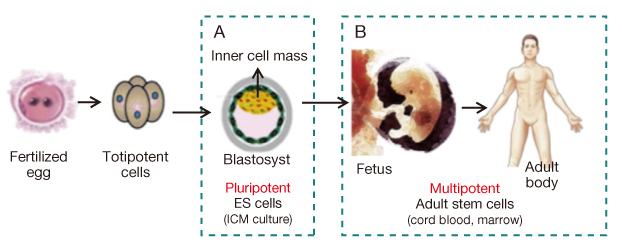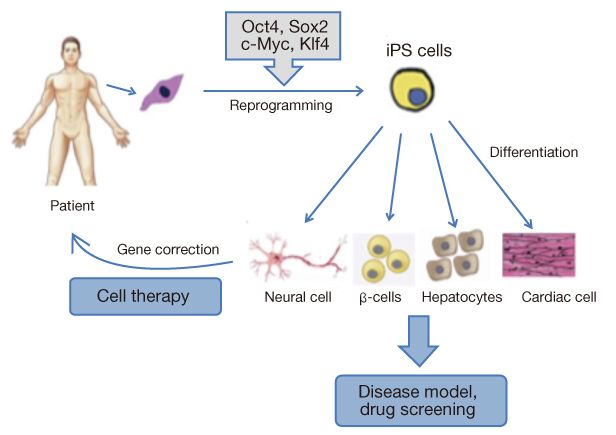J Korean Med Assoc.
2011 May;54(5):450-453. 10.5124/jkma.2011.54.5.450.
Stem cells: general information and perspectives
- Affiliations
-
- 1Department of Physiology, Brain Korea 21 Project for Medical Science, Yonsei University College of Medicine, Seoul, Korea. dwkim2@yuhs.ac
- 2Severance Biomedical Science Institute, Yonsei University College of Medicine, Seoul, Korea.
- 3Stem Cell Research Center, Seoul, Korea.
- KMID: 2190699
- DOI: http://doi.org/10.5124/jkma.2011.54.5.450
Abstract
- We are now in the middle of stem cell war. Each country is trying to invest a large amount of funds into stem cell research. This is due to a potentiality of stem cells. Stem cells are capable of proliferating in an undifferentiated manner and are able to differentiate into a desired cell lineage under certain conditions. These abilities make stem cells an appealing source for cell replacement therapies (regenerative medicine), the study of developmental biology and drug/toxin screening. In addition to embryonic and adult stem cells, induced pluripotent stem (iPS) cells has been recently generated through reprogramming from adult tissue cells such as fibroblasts. This technique has opened up new avenues to generate patient- and disease-specific pluripotent stem cells. Human iPS cells may be useful for gaining valuable insight into the pathophysiology of disease, as well as for discovering for new prognostic biomarkers and drug screening. Moreover, the iPS cell technology may play a major role in immune-matched clinical application in the future. In this chapter, we introduce general characteristics of various stem cells, clinical application of stem cells and future perspectives.
Keyword
MeSH Terms
Figure
Reference
-
1. Thomson JA, Itskovitz-Eldor J, Shapiro SS, Waknitz MA, Swiergiel JJ, Marshall VS, Jones JM. Embryonic stem cell lines derived from human blastocysts. Science. 1998. 282:1145–1147.
Article2. Mimeault M, Batra SK. Recent progress on tissue-resident adult stem cell biology and their therapeutic implications. Stem Cell Rev. 2008. 4:27–49.
Article3. Park IH, Zhao R, West JA, Yabuuchi A, Huo H, Ince TA, Lerou PH, Lensch MW, Daley GQ. Reprogramming of human somatic cells to pluripotency with defined factors. Nature. 2008. 451:141–146.
Article4. Shi Y, Do JT, Desponts C, Hahm HS, Schöler HR, Ding S. A combined chemical and genetic approach for the generation of induced pluripotent stem cells. Cell Stem Cell. 2008. 2:525–528.
Article5. Takahashi K, Yamanaka S. Induction of pluripotent stem cells from mouse embryonic and adult fibroblast cultures by defined factors. Cell. 2006. 126:663–676.
Article6. Yu J, Vodyanik MA, Smuga-Otto K, Antosiewicz-Bourget J, Frane JL, Tian S, Nie J, Jonsdottir GA, Ruotti V, Stewart R, Slukvin II, Thomson JA. Induced pluripotent stem cell lines derived from human somatic cells. Science. 2007. 318:1917–1920.
Article7. Zhou H, Wu S, Joo JY, Zhu S, Han DW, Lin T, Trauger S, Bien G, Yao S, Zhu Y, Siuzdak G, Schöler HR, Duan L, Ding S. Generation of induced pluripotent stem cells using recombinant proteins. Cell Stem Cell. 2009. 4:381–384.
Article8. De Bari C, Kurth TB, Augello A. Mesenchymal stem cells from development to postnatal joint homeostasis, aging, and disease. Birth Defects Res C Embryo Today. 2010. 90:257–271.
Article9. McKenna DH, Brunstein CG. Umbilical cord blood: current status and future directions. Vox Sang. 2011. 100:150–162.
Article10. Rizzoti K. Adult pituitary progenitors/stem cells: from in vitro characterization to in vivo function. Eur J Neurosci. 2010. 32:2053–2062.
Article11. Fraser JK, Schreiber RE, Zuk PA, Hedrick MH. Adult stem cell therapy for the heart. Int J Biochem Cell Biol. 2004. 36:658–666.
Article12. Fukuda H, Takahashi J, Watanabe K, Hayashi H, Morizane A, Koyanagi M, Sasai Y, Hashimoto N. Fluorescence-activated cell sorting-based purification of embryonic stem cell-derived neural precursors averts tumor formation after transplantation. Stem Cells. 2006. 24:763–771.
Article



